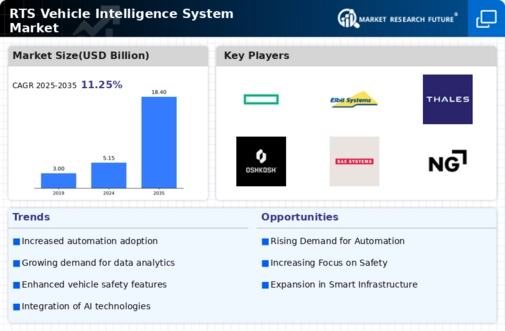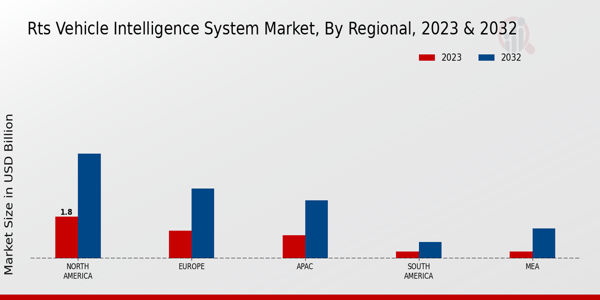Market Growth Projections
The Global RTS Vehicle Intelligence System Market Industry is poised for substantial growth, with projections indicating a market size of 5.15 USD Billion in 2024 and an anticipated increase to 18.4 USD Billion by 2035. This growth trajectory suggests a compound annual growth rate (CAGR) of 12.25% from 2025 to 2035. Such figures highlight the increasing investment in vehicle intelligence systems as manufacturers and consumers alike recognize their value. The market's expansion is likely to be fueled by advancements in technology, regulatory support, and evolving consumer preferences, positioning it as a dynamic sector within the automotive industry.
Increasing Demand for Autonomous Vehicles
The Global RTS Vehicle Intelligence System Market Industry is experiencing a surge in demand driven by the increasing adoption of autonomous vehicles. As manufacturers integrate advanced driver-assistance systems (ADAS) and autonomous functionalities, the need for sophisticated vehicle intelligence systems becomes paramount. These systems enhance safety, efficiency, and user experience, aligning with consumer preferences for automated driving solutions. By 2024, the market is projected to reach 5.15 USD Billion, reflecting a growing trend towards automation in the automotive sector. This shift indicates a potential for substantial growth as more vehicles incorporate these technologies, thereby expanding the market landscape.
Rising Consumer Awareness and Preferences
Rising consumer awareness and preferences for smart technologies are shaping the Global RTS Vehicle Intelligence System Market Industry. As consumers become more informed about the benefits of vehicle intelligence systems, such as enhanced safety features and improved driving experiences, demand is likely to increase. This shift in consumer behavior is prompting manufacturers to prioritize the development of intelligent systems that cater to these preferences. The market is expected to grow significantly, with projections indicating a rise to 18.4 USD Billion by 2035. This consumer-driven trend underscores the importance of innovation in meeting evolving expectations within the automotive sector.
Government Regulations and Safety Standards
Government regulations and safety standards play a crucial role in shaping the Global RTS Vehicle Intelligence System Market Industry. Regulatory bodies are increasingly mandating the incorporation of advanced safety features in vehicles, which necessitates the integration of intelligent systems. For instance, regulations aimed at reducing road fatalities and enhancing vehicle safety are pushing manufacturers to adopt technologies that monitor vehicle performance and driver behavior. This regulatory environment not only fosters innovation but also drives investment in vehicle intelligence systems. As a result, the market is likely to witness robust growth, supported by compliance with evolving safety standards.
Growing Focus on Fleet Management Solutions
The Global RTS Vehicle Intelligence System Market Industry is witnessing a growing focus on fleet management solutions, driven by the need for operational efficiency and cost reduction. Companies are increasingly adopting intelligent systems to monitor vehicle performance, track assets, and optimize routes. This trend is particularly evident in logistics and transportation sectors, where real-time data analytics can lead to significant savings. The market is projected to expand as businesses recognize the value of integrating these systems into their operations. As fleet management becomes more sophisticated, the demand for advanced vehicle intelligence systems is expected to rise, further propelling market growth.
Technological Advancements in AI and Machine Learning
Technological advancements in artificial intelligence (AI) and machine learning are significantly influencing the Global RTS Vehicle Intelligence System Market Industry. These technologies enable vehicles to process vast amounts of data in real-time, enhancing decision-making capabilities and operational efficiency. For example, AI-driven systems can analyze traffic patterns, predict potential hazards, and optimize route planning. This capability is expected to attract investments and drive market growth, with projections indicating a compound annual growth rate (CAGR) of 12.25% from 2025 to 2035. As AI continues to evolve, its integration into vehicle intelligence systems will likely redefine industry standards.





















